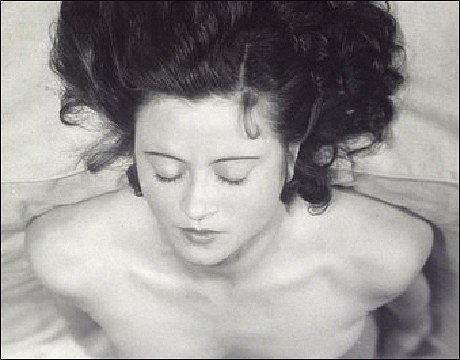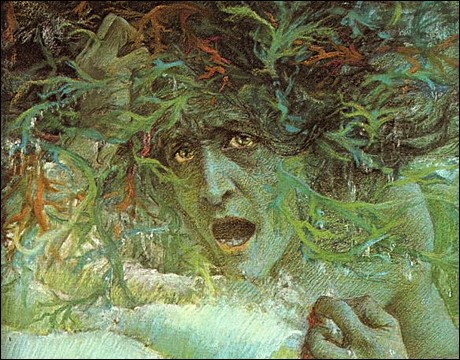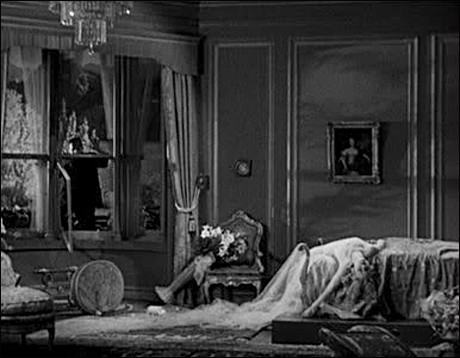Must-See Paris: Fantasy and la Femme Fatale

Tue 9 Apr 2013
Do you love old Hollywood horror, film noir and Frankenstein? Are you a fan of gothic fashion? Or do you just relish devils, vampires and ghosts? Say yes to any of these and your must-see Paris stop has to be the Musée d’Orsay‘s exposition “The Angel of the Odd.” Despite a rather clumsy name, this ingenious show (subtitled “Dark Romanticism”) uses art to explore the 20th century’s most seductive fears. Just check out the museum’s video teaser!

Death of the Gravedigger (detail), by Carlos Schwabe. Photo: Musée d’Orsay.
Often associated with black-clad teens or fashion by Alexander McQueen, romanticism’s shadowy side has an impressive history in art. The d’Orsay’s show, cocurated with the Städel Museum in Frankfurt, begins just before the French Revolution. Then, as England’s Gothic novels sent the first innocent heroines into deserted castles, art avidly took up themes of terror, the monsters and the unexpected. Soon painters, sculptors and engravers were all competing to portray the sensations of fear.

Head of Medusa, by Arnold Böcklin. Photo: Musée d’Orsay.
This serious love affair with darkness passed through a series of European movements: Romanticism, Symbolism, Expressionism and Surrealism. Some of the artists here—such as Goya, Géricault and Delacroix—focused on real worries and political pessimism. Others, such as William Blake, Edvard Munch, Odilon Redon, Gustave Moreau, John Henry Fuseli and Rodin, specialiszd in the erotic side of apprehension and fright.

Medusa, by Lucien Lévy-Dhurmer. Photo: Musée d’Orsay.
At the heart of this Romanticism lie two tendencies. One of these is the depiction of disturbing visions—eerie seascapes, forbidding forests and ultraghostly graveyards. The second, of course, is la femme fatale, a character destined for vampire stories and 1940s film noir. Here, she is sometimes shown as just a damsel in distress. Other times artists see her as a cruel and capricious beauty. There are plenty of frankly evil women, too, often portrayals of characters from famous poems or myths. In every case, they are always both magnificently sexy.

Renée Jacobi (detail), by Jacques-André Boiffard. Photo: Musée d’Orsay.
The list of artists displayed in the show is pretty incredible. It may be a guilty pleasure to enjoy such decadent favorites as Gustave Moreau, Henry Fuseli, Odilon Redon and James Ensor. But the d’Orsay has supplied many top-shelf participants too—featuring sculptures by Rodin, classic landscapes by Caspar David Friedrich and surprising works from Impressionists like Bonnard, Vuillard and Gauguin. There are even Surrealists from Dalì to Magritte.

Photo of ghosts, 1910, anonymous (detail). Photo: Musée d’Orsay.
For me, the biggest treats were Goya’s legendary engravings—sets that form part of his two famous series, “The Disasters of War” and “The Caprices.” Of special interest is one called The Chinchillas. It was this caricature of no-good aristocrats that inspired the look of Boris Karloff’s Frankenstein. A clip from that masterpiece by James Whale also shows how one crucial scene was copied from another landmark painting. This one, Fuseli’s The Nightmare, is also part of the show.

The Nightmare, by Henry Fuseli (Füssli). Photo: Musée d’Orsay.
The exhibit is a big one that mixes high works with low; academic salon paintings sit side by side with fabulous kitsch. Yet one feels that every artist in it would relish skeletons dancing in ball gowns just as much as you do. So prepare to have fun and be mesmerized—especially by the excerpts from films. Nicely installed in stylish mini cinemas, these juxtapose classics with rare European silents. (Many of the latter clips are scarier than those from the speaking films.)

Frankenstein, by James Whale (detail). Photo: Musée d’Orsay.
The best-known extracts come from Three Lights, by Fritz Lang (1921); Murnau’s Nosferatu (1922); Dracula, by Tod Browning (1931); Rebecca, by Alfred Hitchcock (1940); and Los Olvidados, by Luis Buñuel (1950). In addition to offering some shivers, this is certainly must-see Paris cinema. From April 27 to May 19, every Saturday the d’Orsay also holds special showcases of scary silent films. The rarities focus on demons, devils and other romantic terrors. Admission is 6 euros, but be sure to book ahead!

The Madness of Kate (detail), by Henry Fuseli (Füssli). Photo: Musée d’Orsay.
TIP
If you enjoy this show, or you’re looking for more dark thrills in Paris, check out the Musée National Gustave Moreau in the 9th Arrondissement. Former home to one of the weirdest painters ever, it’s a local favorite. The kitschy palace is so popular it even featured on the TV cop show “Engrenages” (Spiral). What was it? The stalking ground of a sinister killer!
“The Angel of the Odd” is on view at the Musée d’Orsay through June 9, 2013.
Related Links
“The Angel of the Odd”
Musée d’Orsay
The museum’s video teaser
Musée National Gustave Moreau
“Engrenages” (Spiral)
Editor’s note: Do you follow us yet on Tumblr, Pinterest and Instagram? If not, why wait? It’s free, fun and a beautiful reminder of our favorite city—Paris of course!